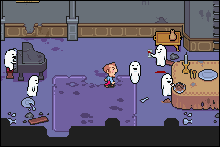
A screenshot from Mother 3
|
They don’t make games like Earthbound anymore.
Released by Nintendo in 1995, Earthbound is the story of Ness, a typical suburban boy who lives in a town called Onett. One night, a meteor crashes into a mountain near Ness’ house. That’s when a bee named Buzz Buzz appears from the future and declares that the Apple of Enlightenment has predicted Ness will save the world from a formless malevolent force known as Giygas. On said quest to save the world, Ness encounters everything from an enemy called a “Diamond Dog” to music that samples Monty Python. Earthbound offered quirks and oddities that, to this day, have not been matched.
Save an occasional cameo by Ness in other Nintendo titles and an infamously scrapped Nintendo 64 sequel, though, the game remained perpetually under the radar aside from an extremely dedicated cult following.
In late fall of last year, more than a decade after Earthbound’s release, creator Shigesato Itoi announced an EB sequel seemingly out of nowhere. About half a year later, the game saw Japanese release on April 20, 2006. This past spring and summer, the stateside fan community waited anxiously for the announcement of an American release of the game, dubbed Mother 3.
The announcement never came. Enter Austin-based software engineer Cliff Spradlin.
ADVERTISEMENT
 |
“Some of us have been waiting over a decade (for an EB sequel),” says Spradlin over Instant Messenger from Austin, where he’s a student at the University of Texas, “so when the actual release date was announced at the end of last year, I realized I had the technical ability to convert Mother 3 to English.”
Spradlin, 20, is the webmaster and project manager of mother3.org, a website dedicated to translating the entirety of Mother 3 without the aid of Nintendo or any other gaming organization. The mother3.org team started with three and has since risen in size to about eight, but the project is a true labor of love for Spradlin, who makes clear his adoration for the game: “Earthbound was a real joy when I was growing up,” he says, “and I really wanted to [translate] its sequel not only for myself, but also for others who have been hoping for it to be released for so many years.”
He references the disappointment he felt at the cancellation of Earthbound 64, explaining it happened at an inopportune time in his life. “[It was] right near the end of middle school, and my parents were going through a divorce. For me [Earthbound 64] was one of only a couple things I had to look forward to.” He doesn’t want another generation of players to wind up disappointed.
Since the project began in April, Spradlin and his team have translated approximately seven-and-a-half of Mother 3’s eight chapters. In spite of the team’s speedy progress, though, Spradlin emphasizes the day-to-day drudgery of translating a game so reliant on its text. “We’re doing our best to capture the original style,” says Cliff, “but it’s really hard.”
To wit: In Mother 3, the player sees frogs throughout the game’s landscape. They need to stop at these frogs in order to record their progress in the game. “It's a pun,” explains Spradlin. “Japanese has a much more limited subset of syllables than English, and as such there are many, many more homonyms. The Japanese word for frog is kaeru. Now, there are about 9 completely different meanings for kaeru. The frogs are a pun. Kaeru also means ‘to return, ‘ or ‘to go home’ (i.e. a save point.) It's basically impossible to capture that pun.”
Spradlin and his team, who all have day jobs and do this for free in their spare time, must balance between perfectionism and practicality in remaining faithful to their source material. “We thought about turning the frogs into ruby slippers,” he says, “but it’s a very scary thing to go around modifying the intent of the game.” He adds: “The best translation won't happen for a few versions at least after the initial release.”
Spradlin explains that this much thought is put into nearly every aspect of the translation. The games are packed with cultural references, puns, and other tricky linguistic jokes. “Usually fan translations just don't bother,” he says, “But this is probably the only experience of Mother 3 Americans will get, so we're trying to get it right.”
Indeed, the project’s target demographic will likely be difficult to please. Spradlin and his primarily (though not entirely) unprofessional crew have saddled themselves with the task of providing new content to one of videogaming’s only true cult fanbases. The nature of Mother 3’s following makes Spradlin’s mission even harder, unless he plays ball with the fans.